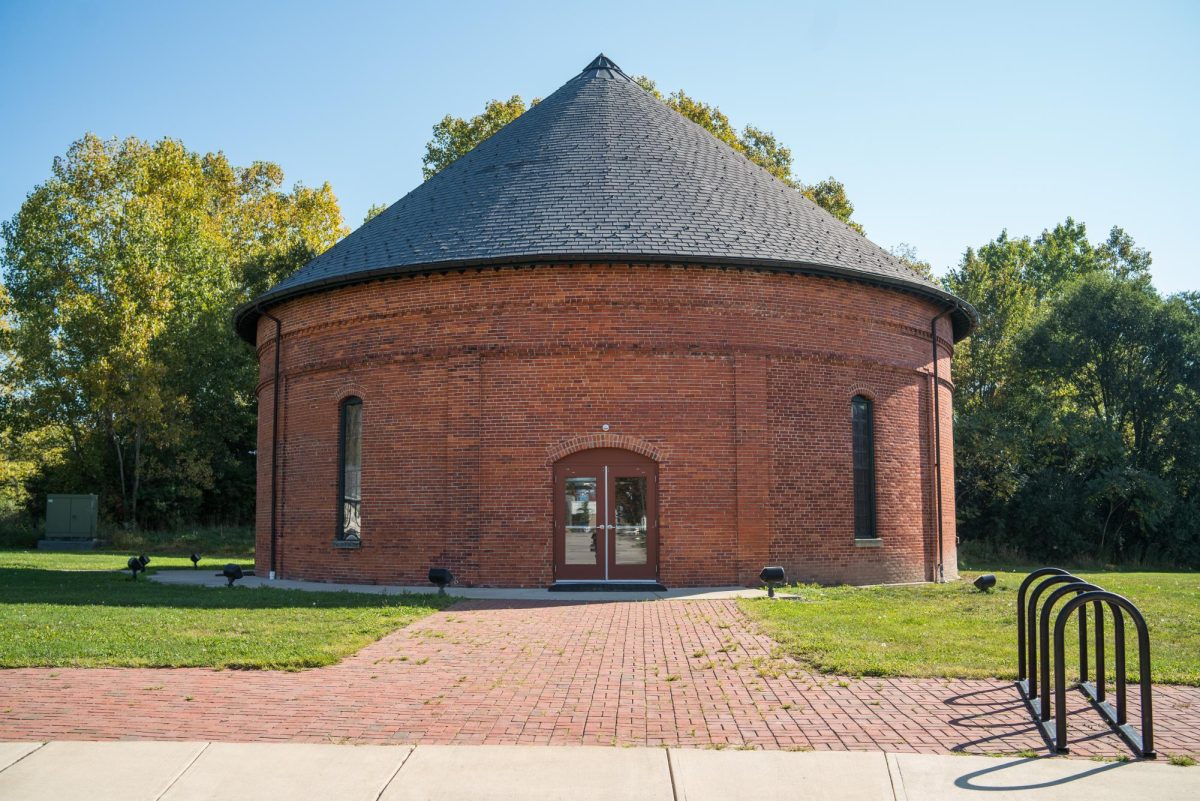On Saturday, Oct. 7, the Oberlin Underground Railroad Center held its grand opening in the historic Oberlin Gasholder building on South Main Street. The Gasholder building has been renovated to serve as a meeting place and exhibition space following an almost twenty-year effort.
At the grand opening, artifacts were on display in an exhibit curated in collaboration with the Oberlin College Special Collections along with artwork by Oberlin High School students. The Oberlin Underground Railroad Center Implementation Team envisions the Center will be used to showcase historical and artistic exhibits and hold performances focusing on the experiences of enslaved people, according to those working on the project.
“The space will be really dedicated showcasing some of the art and history of the slave times,” City Council Member Elizabeth Meadows, who serves as City Council liaison to the Implementation Team, said. “City officials have visions of it being able to be used by regular citizens for celebrations, but for the most part, the vision is mainly for it to be a good, comfortable place for Black history to be housed, celebrated, and preserved.”
Exact plans for how the Underground Railroad Center will be used have not been finalized. Currently, the Implementation Team is in the process of transitioning to become a nonprofit that will decide how the space is used. All their decisions will have to be approved by the City, which owns the building.
Oberlin City Code Administrator and City Liaison to the Implementation Team Chris Yates mentioned the City’s interest in renting the space out for private events such as weddings and family reunions in addition to its use as a cultural center. He also said that telling the stories of enslaved individuals was a major part of the center’s vision.
“Most of the stories in Oberlin revolve around … the abolitionist movement in Oberlin,” Yates said. “The Oberlin Underground Railroad Implementation Team wanted this building to be dedicated to and tell through exhibits the life that the slave led.”
The Gasholder building was built in 1889 to store coal gas that was used to power street lamps around town. It was used only briefly before falling into disuse and disrepair. The structure was almost torn down, but an effort led by citizens to save the building resulted in it being donated to the City in 2004. The Gasholder building was listed on the National Register of Historic Places in 1998.
Meadows said that there was already an interest in creating an Underground Railroad Center when she moved to Oberlin in 2001. In 2007, a design team was assembled, but the team lacked the funds to fully renovate the building. The team fundraised, and some construction was completed. However, the space remained unusable until the City agreed to put up the funds to finish the renovation in 2019.
Yates described the extent of the renovations necessary to bring the building up to code and make it a usable, public space. Proper drainage had to be established, a concrete support beam had to be installed in the basement, and the floor had to be leveled and finished. Additionally, the City installed heating and air conditioning, built a small stage for performances, and widened the entrance to allow for an increased capacity of 272 people. The cost of the project totaled over $500,000.
“It’s [an] exhibition room, basically short of a museum,” Yates said. “They didn’t think we could get the air quality in there for museum quality. I think now with the system we have in there, we can, so that changes it a little.”
During the grand opening, artifacts from the Oberlin College Special Collections’ Anti-Slavery Collection were on display. It included shackles, a piece of a whipping post from a jail, and illustrations of the African coast from the era of the slave trade. Special Collections and Preservation Assistant Gena Reynolds said that these items were chosen from the collection by the members of the Implementation Team. The Anti-Slavery Collection was compiled throughout the 19th century and incorporated in Oberlin College’s first library in 1885. Most of the items in the collection pertain to the abolition movement, but some artifacts, like those displayed at the Underground Railroad Center opening, are directly related to slavery.
“[The artifacts] were collected following the Civil War as proof of what had happened and because people were interested in preserving that history,” Reynolds said.
The one permanent exhibit in the Underground Railroad Center will be the tombstone of Lee Howard Dobbins. Dobbins was a four-year-old child, born into slavery, who came to Oberlin in 1853 with his adoptive mother who was fleeing enslavement with her other children. Dobbins was ill and had to be left in Oberlin as the family continued on their journey to freedom. He died shortly after, which left a large impact on the Oberlin community. His funeral at First Church was attended by over a thousand people.
“I think it was a very tragic moment for the community and drove home the horrible things that were happening at that time,” Reynolds said. “It’s an event that I think the people in Oberlin really talked about a lot and wanted to make sure that people knew what had happened. There are multiple anti-slavery newspapers that run stories about it and talk about Dobbins’ death in our collection.”
Dobbins was buried under a tombstone emblazoned with the words “Let Slavery Perish!”
“The sandstone tombstone was removed from the graveyard to save it from rain damage,” Reynolds said. It remained in the Special Collections, despite belonging to the City, until it was returned to become part of the Underground Railroad Center.
Meadows described the public’s response to the Underground Railroad Center as positive.
“On Juneteenth, there was a soft opening. Some of the community members were invited to come in,” she said. “And I have to say that the people who came in were just joyous. I like to use that word, because they were all smiling and happy and came inside and just walked around and made very positive comments about the interior of the building because they had seen it as an eyesore for many, many years, and now it’s not.”
Yates said that there are plans to install bathrooms in the center to accommodate for times when the restrooms at the nearby picnic pavilion are closed. He also said he hoped the Center would be able to collaborate with the Oberlin College Special Collections on another exhibition in the near future.






